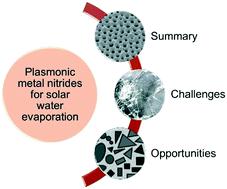当前位置:
X-MOL 学术
›
Environ. Sci.: Water Res. Technol.
›
论文详情
Our official English website, www.x-mol.net, welcomes your
feedback! (Note: you will need to create a separate account there.)
Plasmonic metal nitrides for solar-driven water evaporation
Environmental Science: Water Research & Technology ( IF 3.5 ) Pub Date : 2020-11-09 , DOI: 10.1039/d0ew00534g Matthew J. Margeson 1, 2, 3, 4 , Mita Dasog 1, 2, 3, 4
Environmental Science: Water Research & Technology ( IF 3.5 ) Pub Date : 2020-11-09 , DOI: 10.1039/d0ew00534g Matthew J. Margeson 1, 2, 3, 4 , Mita Dasog 1, 2, 3, 4
Affiliation

|
Meeting the demand for clean freshwater is now a major global challenge due to persistently increasing human population coupled with the adverse effects of climate change. Solar-driven water evaporation provides for both desalination and disinfection and thus is a simple, green method to generate clean freshwater. Water by itself does not strongly absorb solar insolation and thus solar evaporation requires an effective absorber material to mediate the optical to thermal energy transformation. The strong light-material interactions and heat generation in plasmonic materials have made them attractive candidates for water evaporation technologies. Of these, plasmonic metal nitrides have garnered significant interest lately owing to their low-cost, high light-to-heat conversion efficiency, and chemical stability. This review provides a summary of the recent progress in solar-driven water evaporation using plasmonic metal nitrides (TiN, ZrN, HfN). A brief outlook on the current challenges and future directions is also provided.
中文翻译:

等离子体金属氮化物用于太阳能驱动的水蒸发
由于人口的不断增加以及气候变化的不利影响,满足对清洁淡水的需求现在是一项重大的全球性挑战。太阳能驱动的水蒸发既可进行脱盐又可进行消毒,因此是产生清洁淡水的简单,绿色方法。水本身不会强烈吸收太阳光,因此太阳蒸发需要一种有效的吸收材料来介导光能到热能的转换。等离子体材料中强烈的光-材料相互作用和发热使它们成为水蒸发技术的有吸引力的候选者。其中,等离子金属氮化物由于其低成本,高的光热转换效率和化学稳定性而引起了人们的极大关注。这篇综述总结了使用等离激元金属氮化物(TiN,ZrN,HfN)的太阳能驱动的水蒸发的最新进展。还简要介绍了当前的挑战和未来的方向。
更新日期:2020-11-15
中文翻译:

等离子体金属氮化物用于太阳能驱动的水蒸发
由于人口的不断增加以及气候变化的不利影响,满足对清洁淡水的需求现在是一项重大的全球性挑战。太阳能驱动的水蒸发既可进行脱盐又可进行消毒,因此是产生清洁淡水的简单,绿色方法。水本身不会强烈吸收太阳光,因此太阳蒸发需要一种有效的吸收材料来介导光能到热能的转换。等离子体材料中强烈的光-材料相互作用和发热使它们成为水蒸发技术的有吸引力的候选者。其中,等离子金属氮化物由于其低成本,高的光热转换效率和化学稳定性而引起了人们的极大关注。这篇综述总结了使用等离激元金属氮化物(TiN,ZrN,HfN)的太阳能驱动的水蒸发的最新进展。还简要介绍了当前的挑战和未来的方向。











































 京公网安备 11010802027423号
京公网安备 11010802027423号